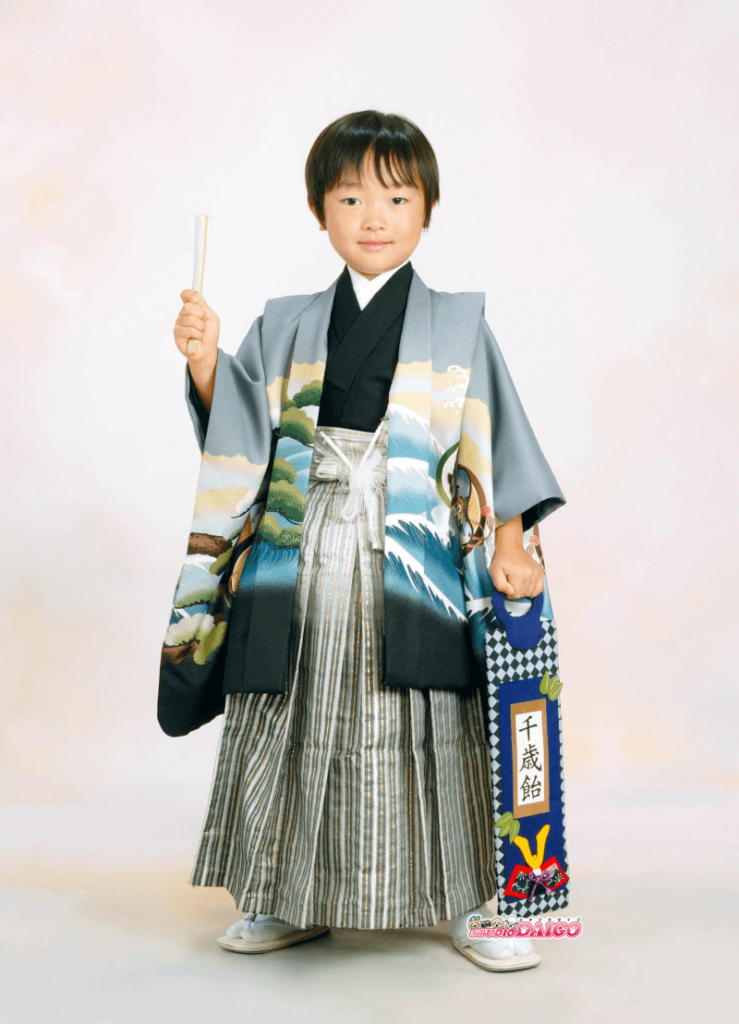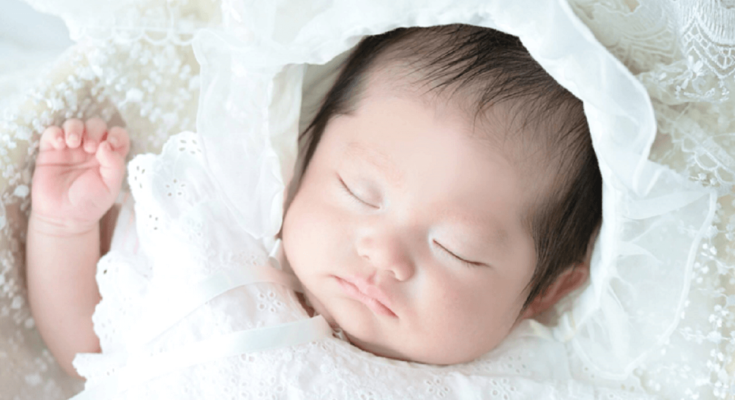The birth of a baby is a great joy for everyone. Every parent wishes for their children to be healthy and happy regardless of where they live. However, the rituals and ways of celebrating vary from country to country. Firstly, I would like to introduce some traditional events that celebrate the growth of a child in Japan, especially the various events during the first year after birth.
■Oshichiya (お七夜) seventh day after birth
On the seventh day after birth, families celebrate the safe birth of their baby. It is called “a naming ceremony” (命名式), and the baby’s name is generally written on a piece of paper with a brush.
■Omiyamairi(お宮参り)around one month old

Around one month after birth, they take their baby to a local shrine to report the birth to the god of the land and pray for the healthy growth of the baby. In general, the baby’s grandmother holds the baby and drapes a kimono over him or her.
■Okuizome(お食い初め)around one hundred days old

“Okuizome” is a ceremony to give food to a baby for the first time when the baby is 100 to 120 days old. A feast is prepared with the hope that the baby will have no trouble eating for the rest of his or her life. But babies actually cannot eat solid food yet, so parents only pretend to feed them. A typical feast includes whole grilled sea bream, red rice, soup, boiled vegetables, and pickles. Also, a stone called “hagatame-no-ishi” (歯固めの石) is used in this ceremony. Parents place the chopsticks on it and hold them against the baby’s gums, hoping the baby will grow strong teeth.
■Hatsu-sekku(初節句)Girls : March 3 Boys : May 5

In Japan, March 3 and May 5 are called Momo-no-sekku (桃の節句) and Tango-no-sekku (端午の節句), which are celebrations for girls and boys respectively. The first celebration after a child’s birth called Hatsu-sekku is particularly cherished. Hina dolls are displayed for the girls’ festival. Armor or samurai helmets are the decorations for the boys’ festival and also carp streamers are set up in hopes of encouraging the child’s growth. Usually, grandparents are invited to the celebration. If babies are one to three months old, parents may delay the first festival until the following year.

■First Birthday(初誕生日)one year old

The first birthday ritual varies from region to region, such as having the baby carry “issho mochi,” wrapped in a furoshiki cloth on his or her back, or having the baby step on the mochi with his or her feet. Issho means “1.8 kg of rice” and also means “a lifetime”. People enjoy watching the baby fall over while carrying it. In recent years, it is more common to celebrate with family members around a birthday cake.

■ Shichi-go-san(七五三)Girls : 3 years old and 7 years old. Boys: 3 years old and 5 years old

“Shichi-go-san” is a festival to celebrate the growth of children, and it is customary to visit a shrine or a temple on November 15th. Shichi-go-san literally means seven-five-three in Japanese. The celebration is for both boys and girls at the age of three, only for boys at the age of five, and only for girls at the age of seven. This age is related to the traditional rituals which are “kamioki” (髪置き) when both boys and girls began to grow their hair, “hakama gi” (袴着) when boys started wearing hakama, and ”obitoki”(帯解き) when girls began to tighten the belt of their kimono. These ceremonies date back to old samurai families. Today it is common for girls to wear kimonos and for boys to wear hakamas and visit a shrine or a temple with their families to offer a prayer. Children get long red-and-white stick candy called chitose-ame. Chitose means “one thousand years”. It symbolizes health and longevity.

In the old days, the mortality rate of children was very high, so people celebrated their growth at these milestones and prayed for their longevity and happiness. All of these events described above have time-honored customs and rituals that vary based on the region, but in recent years they are being simplified and held in more convenient ways for families. The form of celebrating a child’s growth may have changed, but the parental love for their children has not.
Photos are essential for these events. All of the photos above were taken at photo studios. Photo studios are gaining popularity these days. Many parents want their children’s cute images to be treasured for a lifetime, and photo studios are responding to this need by offering a variety of services to attract customers.
■ Studio Alice

Studio Alice is by far the most popular photo studio for children in Japan today. First of all, they offer a wide range of rental costumes and give customers the pleasure of choosing their own outfits. Next, you may be anxious about your child’s behavior because it is difficult to take pictures of children, especially small children up to the age of two. But no worries! The staff are not professional photographers but they are used to handling children, so you can leave it to them with peace of mind. I take my hat off to the professional techniques that bring out the best smiles. Even babies as young as one month old can look at the camera and smile.
■ Entrance and Graduation Ceremony
The events continue even after the children are old enough to start elementary school. In Japan, entrance ceremonies and graduation ceremonies take place at each school, and both are major events that many parents participate in while wearing formal attire. It is not uncommon for parents to attend even junior high and high school ceremonies. They share their joy for their children’s growth with others.
■ Sports Festival

Lastly, I would like to introduce another school event that many parents are most looking forward to. It’s a sports festival. It is an annual event that takes place in the spring or fall. On that day the students join not only individual competitions like various styles of running races but also many team performances such as characteristic local dancing, group gymnastics and cheering competitions. Some parents even take the day off to come to school and cheer on their children with video cameras in hand. This occurs not only for elementary sports festivals, but junior high and high school festivals as well. I think there are similar events in other countries like field day, but sports festivals in Japan are unique in that all the students at school are supposed to participate. They practice performing for days during P.E. periods before the actual day.

There is probably no other country that puts as much effort into sports events as Japan. Many foreign people seem surprised to see that students are very organized and good at group activities. Among the many events on that day, group gymnastics is one of the highlights. This is a form of gymnastics in which people create various forms by linking bodies, standing on each other’s shoulders, or making a human pyramid. However, in recent years, there have been reports of serious accidents in gymnastics, and there is a need to create programs that incorporate safer techniques.

■ Personal note
The nature of sports festivals has changed over the past 50 years. Many competitions have been left out on the grounds that they were dangerous. In retrospect, my son was not very good at sports, so the practice could have been tough for him, especially in high school when the level of gymnastics required was so high. Perhaps it is one of Japan’s unique features that everyone works together to achieve a single goal. They share the joy of accomplishment by cooperating with friends, which enables them to develop a feeling of togetherness. It is typical of Japanese to value cooperation and harmony. That’s why many parents shed tears to see their children’s outstanding performances. I’d like to believe the sports festival will give children the ability to be the best they can and have fun together with their parents.

Thank you for reading my article!
Lives in Takatsuki city, Osaka. Has been engaged in English for work and fun for years.





 HTJ has a YouTube page! Check it out
HTJ has a YouTube page! Check it out